| Author |
Message |
Stephane Rabier

|
 Posted: Wed 04 Jul, 2012 2:40 am Post subject: Id an old sharpening stone? Posted: Wed 04 Jul, 2012 2:40 am Post subject: Id an old sharpening stone? |
 |
|
Hi,
this morning my wife has just dropped my grandfather's sharpening stone while moving everything in the kitchen, nice day.
I was using it since I'm a kid, my grandfather for times before and I've never seen a stone half as good as this one, just magic!
The colour is a little bit more pinkish than the picture shows.
It's very hard : if I try to scratch an artificial stone with a broken saw blade, the stone is scratched but with that stone the saw blade looses half a millimeter and the stone is still intact.
As there's a lot of sharpening artists on the forum, I hope someone could help me identify that stone so I can try to find a new one.
The size is about 100x45x13mm (from the sides).
I guess that was *the* top quality sharpening stone as my grandfather was never buying cheap tools.
So what do you think : Belgian yellow coticule, Arkansas stone, Indian, Japanese?
 Attachment: 32.4 KB Attachment: 32.4 KB

|
|
  |
 |
|
Michael R. Mann
Location: Germany Joined: 26 Jun 2012
Posts: 28
|
 Posted: Wed 04 Jul, 2012 4:58 pm Post subject: Posted: Wed 04 Jul, 2012 4:58 pm Post subject: |
 |
|
The sharpening stone Belgian yellow coticule is also known as "Belgischer Brocken" and often combined with a layer of slate.
If I see the stone on your picture I don't think it's a coticule
|
|
  |
 |
Stephane Rabier

|
 Posted: Wed 04 Jul, 2012 11:03 pm Post subject: Posted: Wed 04 Jul, 2012 11:03 pm Post subject: |
 |
|
Hi Michael,
thanks for your reply. I don't know if some 70-80 years ago they already used to glue their stones on a slate base or if they started doing this as the vein was going thinner and the stone more rare and expensive 
One thing is sure : several kind of sharpening stones (including the coticule) are supposed to make some "milk" when wet and rubbed with a blade, mine definitely doesn't! The blade will loose some visible particles, not the stone.
|
|
  |
 |
|
|

